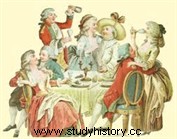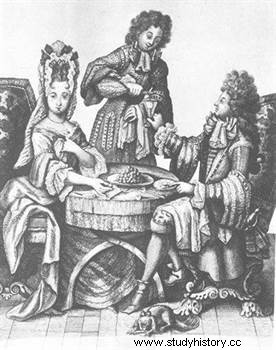 “Drink for the King shouted by the cupbearer signifies that the wine and water ceremony can begin at the Grand Couvert table. It is customary to cut wine with water and the King appreciates this drink. But what is this ceremony? How was the wine obtained? Where was it stored? What wine was at the King's table?
“Drink for the King shouted by the cupbearer signifies that the wine and water ceremony can begin at the Grand Couvert table. It is customary to cut wine with water and the King appreciates this drink. But what is this ceremony? How was the wine obtained? Where was it stored? What wine was at the King's table?
Wine serving ceremony
When the king wishes to drink, the cupbearer posted at his side exclaims "A drink for the King". Preceded by a guard, he goes to the buffet where the head of the Echansonnerie-Bouche is permanently kept. The latter gives the cupbearer a gold tray, on which are two decanters, vermeil wine tasters and the king's glass which is covered to prevent poisoning.
Returning to face the king, the two characters make a deep bow, then begin experiments by mixing wine and water, tasted first by the head of the Echansonnerie- Mouth and second by the cupbearer. If the test is conclusive (that is to say, neither the water nor the wine is poisoned), the cupbearer after a new bow, uncovers the king's glass, hands him the tray so that the monarch Serve cut wine. When the latter has had enough to drink, he puts his glass back on the tray, the cupbearer covers it and, after a final bow, returns the tray to the chef of the Echansonnerie-Bouche, who brings it back to the buffet. During major ceremonies, a guard carrying a rifle on his shoulder accompanies the procession from the buffet to the table.
 For daily drinking needs, the king finds two bottles of wine and two jugs of water, in the "canteen" installed in a cabinet adjoining his apartments.
For daily drinking needs, the king finds two bottles of wine and two jugs of water, in the "canteen" installed in a cabinet adjoining his apartments.
When hunting or traveling, the monarch has two silver flasks for water and wine stored in a suitcase of red cloth trimmed with gold, stamped with its arms.
Buying wine
The purchase of wine is the responsibility of the Grand Master of France, belonging to the Civil House of the King. At Versailles, the princes of Condé hold this office. Once the Grand Provost of France has fixed the maximum price at which the wine can be negotiated, the Grand Master of France makes a contract before a notary, mentioning the price, the quantities of good wine for the king and that for the Common, c that is to say all the people having mouths at Versailles, apart from the king and the princes.
Suppliers are privileged merchants, licensed by the king, with the status of wine merchants and innkeepers. Their number is significant:in 1683, there were 20 wholesale and retail wine merchants and 14 innkeepers. They also have an exceptional status:they travel freely to the terroirs, bring their cargo back safely, have tax exemptions and can block the sale of wine from a producer to other merchants until they decide on the quantity and quality they want.
Wine storage
In principle, the wine is stored on the quays and near the ports of Paris. When the king is at Versailles, the main cellars are in Sèvres for the first major supplier or in a house adjoining the Grand Commun for the second major supplier.
Among the 350 servants taking care of the meals and drinks of the king, princes and officers, the Ordinary Controller of the Mouth is in charge of wine and water, searches the warehouses for the quantities needed for the day and locks them away.
In the time of Louis XV, bottles were prepared for the day, stored in the basement near the Petite Cour du Roi. Under Louis XVI, the reserves were installed in the vaulted cellars of the Grand Commun.
The different wines of the kings of France
Thanks to the Memoirs of the First valets de chambre or the inventories after the death of wine merchants, we discover the number of bottles and the variety of wines consumed in the time of the kings at Versailles.
Champagne wine
Louis XIV would have tasted it for the first time in 1654 and was his favorite drink until 1694. At that time, it was white or red, sparkling or "still" , eaten at table, used in cooking and the whole Court appreciates it. The Regent does not organize his libertine evenings without champagne and Madame de Pompadour says that "this nectar is the only one to leave women beautiful, after having drunk it...". Louis XV appreciated "sparkling" champagne, the cellars of Sèvres held more than 50,000 bottles in 1733, then he adopted "tranquil" champagne around 1740, from Sillery, Epernay or Meregoutte.
Burgundy wine
 It is the prestige wine of Kings. Since the 14th century, the Dukes of Burgundy have watched over their vines and their grape varieties, promoting trade to the North, prohibiting wines from the South from crossing their terroirs. These Burgundy or Beaune wines were served to Pope Gregory XI; Philippe le Hardi sold them to the Netherlands, Belgium and Germany, while remaining in competition with Champagne wine.
It is the prestige wine of Kings. Since the 14th century, the Dukes of Burgundy have watched over their vines and their grape varieties, promoting trade to the North, prohibiting wines from the South from crossing their terroirs. These Burgundy or Beaune wines were served to Pope Gregory XI; Philippe le Hardi sold them to the Netherlands, Belgium and Germany, while remaining in competition with Champagne wine.
From the moment when Fagon, doctor of Louis XIV, decreed that Burgundy wines were healthier, their production and sales increased considerably. Under Louis XV, there are more than 335,000 liters of appellations such as Mâcon, Tonnerre, Irancy, Meursault and in the cellars of Louis XVI, we also find the names Chambertin, Vougeot, Vosne Romanée.
Other wines and foreign wines
According to the 1782 inventory, the king also drank wines from Languedoc, Vauvert, Frontignan, Graves, Sauternes, as well as wines from Bordeaux or more beer, not forgetting Chablis, Malaga, Malvasia wine or even Fronsac wine served very often when Louis XV returned from hunting. Among the foreign wines, one finds as of 1733 wines of Madeira, wines of the Rhine, wines of Alicante. In the inventories under Louis XVI, there is Tokaÿ from Hungary and already nicknamed by Louis XIV “the king of wines and the wine of kings”. Cap de Constance wine arrived in Europe in 1761, created by Bordeaux Huguenots who had fled France for South Africa, a Dutch province.
We see that wine is of great importance:the doctor prescribes it, it is essential on the table, it can be synonymous with prestige depending on the appellation and has a side "holy" since the glass of the Most Christian King is filled with this beverage.
Sources
Revue Château de Versailles n°13, April-May-June 2014, article by Alexandre Loire.
